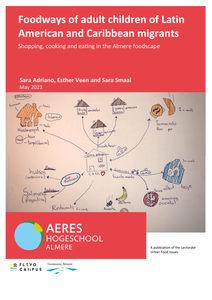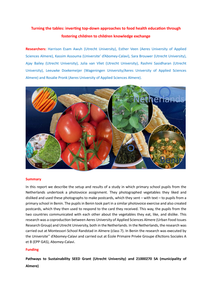The richness of the studies presented is disappearing under a thick sauce of left-wing ideology and perceptions of globalization, making it too easy for ‘the enemy’ to neglect this book. Quotes like ‘To put it crudely, market tyrannies and state despotism have deepened inequalities and abrogate freedom both within and among nations’, are not very helpful in starting a more open debate on the marginalization of young people in different cultures and countries. I think the studies themselves are very convincing and do not need too obvious links to globalizing evil. The research observations are in contrast with the rather blunt social political analyses. The position of social work, given its empowering tradition with regard to excluded groups (such as many of the youth gangs and cultures in this publication), needs to be a self confident approach, focused on giving insight into and improving practices in the life world contexts of young people.
DOCUMENT

Urban tourism increasingly focuses on the role of hospitality in cities, evolving from a means to strengthen tourism as a ‘product’, towards a focus on tourism as an opportunity for revitalization and transformation of destinations. In this context, cities are considered dynamic communities in which ‘hosts’ (entrepreneurs, residents, municipalities) and ‘guests’ (visitors, tourists) co-habitate and co-create multisensorial experiences. This shift in focus comes hand in hand with increasing awareness of competitiveness and sustainability of destinations, expressed by a harmonious relationship between city residents and visitors and a balanced usage of the city as a shared resource. This is of great importance, given the intense usage of urban spaces – the city center of Amsterdam being an illustrative example – and the multiple purposes that these spaces represent for different stakeholders. This paper presents the outcome of a review study into city hospitality experience indicators. We integrate these indicators as a basis for the development of a new scale for measuring the effectiveness of hospitality interventions in relation to outcome variables such as satisfaction and net promotor score (NPS). We thereby provide an important means for scholars and practitioners to develop sustainable tourism actions inclusive of local community interests, in support of efforts toward more balanced city experiences among all stakeholders.
DOCUMENT

Voor het ontwerpen of uitkiezen van het meest geschikte zetmeel in een toepassing wordt gewoonlijk een aanpak op semi-technische schaal via `trial and error' toegepast. Dit is duur en tijdrovend en verreist groet hoeveelheden experimentele proefmonsters.
DOCUMENT
Background: Our aim was to identify dietary patterns by the level of maternal education that contribute to BMI, fat mass index (FMI), and fat-free mass index (FFMI) in children at age 5 and to assess if these dietary patterns are related to BMI at age 10. Methods: Per group (low/middle/high level), Reduced Rank Regression (RRR) was used to derive dietary patterns for the response variables BMI z-score, FMI, and FFMI in 1728 children at age 5 in the Amsterdam Born Children and their Development (ABCD) cohort. Regression analyses were then used to determine the association with BMI at age 10. Results: In each group, pattern 1 was characterized by its own cluster of food groups. Low: water/tea, savory snacks, sugar, low-fat meat, and fruits; middle: water/tea, low-fat cheese, fish, low-fat dairy, fruit drink, low-fat meat, and eggs; and high: low-fat cheese, fruits, whole-grain breakfast products, and low-fat and processed meat. Additionally, in each group, pattern 1 was positively associated with BMI z-scores at age 10 (low: β ≤ 0.43 [95% CI ≤ 0.21; 0.66], p < 0.001, middle: β ≤ 0.23 [0.09; 0.36], p ≤ 0.001, and high: β ≤ 0.24 [0.18; 0.30], p < 0.001). Conclusions: The dietary patterns stratified by the level of maternal education are characterized by different food groups. But in all the groups, pattern 1 is positively associated with BMI at age 10.
MULTIFILE

Jaarboek van de afstudeerders van HAS hogeschool, opleiding Food design 2016 met hun concepten ingedeeld in schakels van de keten: - In het deel Agri & Ingredients zijn ingrediënten en agrarische producten zoals groenten, peulvruchten als startpunt genomen van innovatie. - In het deel Factory treft u technologische innovaties en ontwikkelingen gericht op product, proces en kwaliteitsborging. - In het deel Channel kunt u innovaties in het marktkanaal, zoals blurring, omnichannel en online fooddiensten verwachten. - In het hoofdstuk Consumer zijn concepten te vinden die gericht zijn op specifieke doelgroepen, zoals ouderen, mensen met anosmie en stoeremannen.
DOCUMENT

The research sets out to explore what adult children of migrants consider to be their eating culture and food identity. We do so by looking at how they shop, cook, and eat on a daily basis and what foods they feel connected to. A secondary goal of this research is to understand how important sustainable food is for this group. For this report, we invited adult children of migrants, who grew up in Almere to share their stories. Being born in the Netherlands with parents who were born abroad – in our case Latin-America and the Caribbean – children of migrants grow up in two different food environments simultaneously. Outside the home, they are surrounded by a Dutch food environment, while the eating patterns in and around their household or wider family setting may reflect the backgrounds of their parents.
DOCUMENT

Le chevalier delibere (1483) by Olivier de la Marche has an extensive hermit scene: the hermit receives the author, Acteur, gives him food and drink and instructs him in the important issues of life. Le chevalier delibere thus stands in two main Western European literary traditions: stories about hermits as such (who do or do not provide travellers with food and shelter) and stories in which food and drink have an allegorical function. This paper will discuss both traditions, without attempting to cover all hermit stories or all allegories about food and drink.
DOCUMENT

Understanding taste is key for optimizing the palatability of seaweeds and other non-animal-based foods rich in protein. The lingual papillae in the mouth hold taste buds with taste receptors for the five gustatory taste qualities. Each taste bud contains three distinct cell types, of which Type II cells carry various G protein-coupled receptors that can detect sweet, bitter, or umami tastants, while type III cells detect sour, and likely salty stimuli. Upon ligand binding, receptor-linked intracellular heterotrimeric G proteins initiate a cascade of downstream events which activate the afferent nerve fibers for taste perception in the brain. The taste of amino acids depends on the hydrophobicity, size, charge, isoelectric point, chirality of the alpha carbon, and the functional groups on their side chains. The principal umami ingredient monosodium l-glutamate, broadly known as MSG, loses umami taste upon acetylation, esterification, or methylation, but is able to form flat configurations that bind well to the umami taste receptor. Ribonucleotides such as guanosine monophosphate and inosine monophosphate strongly enhance umami taste when l-glutamate is present. Ribonucleotides bind to the outer section of the venus flytrap domain of the receptor dimer and stabilize the closed conformation. Concentrations of glutamate, aspartate, arginate, and other compounds in food products may enhance saltiness and overall flavor. Umami ingredients may help to reduce the consumption of salts and fats in the general population and increase food consumption in the elderly.
MULTIFILE

Bitterness has been suggested to be the main reason for the limited palatability of several vegetables. Vegetable acceptance has been associated with preparation method. However, the taste intensity of a variety of vegetables prepared by differentmethods has not been studied yet. The objective of this study is to assess the intensity of the five basic tastes and fattiness of ten vegetables commonly consumed in the Netherlands prepared by different methods using the modified Spectrum method. Intensities of sweetness, sourness, bitterness, umami, saltiness and fattiness were assessed for ten vegetables (cauliflower, broccoli, leek, carrot, onion, red bell pepper, French beans, tomato, cucumber and iceberg lettuce) by a panel (n = 9) trained in a modified Spectrum method. Each vegetable was assessed prepared by different methods (raw, cooked, mashed and as a cold pressed juice). Spectrum based reference solutions were available with fixed reference points at 13.3 mm (R1), 33.3mm(R2) and 66.7mm(R3) for each tastemodality on a 100mmline scale. For saltiness, R1 and R3 differed (16.7 mm and 56.7 mm). Mean intensities of all taste modalities and fattiness for all vegetables were mostly below R1 (13.3 mm). Significant differences (p b 0.05) within vegetables between preparation methods were found. Sweetness was the most intensive taste, followed by sourness, bitterness, fattiness, umami and saltiness.In conclusion, all ten vegetables prepared by different methods showed low mean intensities of all taste modalities and fattiness. Preparation method affected taste and fattiness intensity and the effect differed by vegetable type.
DOCUMENT

In this report we describe the setup and results of a study in which primary school pupils from the Netherlands undertook a photovoice assignment. They photographed vegetables they liked and disliked and used these photographs to make postcards, which they sent – with text – to pupils from a primary school in Benin. The pupils in Benin took part in a similar photovoice exercise and also created postcards, which they then used to respond to the card they received. This way, the pupils from the two countries communicated with each other about the vegetables they eat, like, and dislike.
DOCUMENT
